 W
WAegialornis is a genus of prehistoric apodiform birds. It formed a distinct family, the Aegialornithidae, and was in some ways intermediate between modern swifts and owlet-nightjars, lacking the more extreme adaptations to an aerial lifestyle that swifts show today, but already having sickle-shaped wings like them. They do not appear to be a direct ancestor of modern swifts, however, but rather a group that retained an overall basal morphology. Altogether, they were not too dissimilar from modern treeswifts.
 W
WAegialornis is a genus of prehistoric apodiform birds. It formed a distinct family, the Aegialornithidae, and was in some ways intermediate between modern swifts and owlet-nightjars, lacking the more extreme adaptations to an aerial lifestyle that swifts show today, but already having sickle-shaped wings like them. They do not appear to be a direct ancestor of modern swifts, however, but rather a group that retained an overall basal morphology. Altogether, they were not too dissimilar from modern treeswifts.
 W
WBathornis is an extinct lineage of birds related to modern day seriemas, that lived in North America about 37–20 million years ago. Like the closely related and also extinct phorusrhacids, it was a flightless predator, occupying predatory niches in environments classically considered to be dominated by mammals. It was a highly diverse and successful genus, spanning a large number of species that occurred from the Priabonian Eocene to the Burdigalian Miocene epochs.
 W
WBathornithidae is an extinct family of birds from the Eocene to Miocene of North America. Part of Cariamiformes, they are related to the still extant seriemas and the also extinct Phorusrhacidae. They were likely similar in habits, being terrestrial, long-legged predators, some of which attained massive sizes.
 W
WThe order Cathartiformes of raptors or birds of prey includes the New World vultures and the now-extinct Teratornithidae. These raptors are classified by most taxonomic authorities in the order Accipitriformes. In the past, they were considered to be a sister group to the storks of the order Ciconiiformes based on DNA–DNA hybridization and morphology.
 W
WDasornis is a genus of the prehistoric pseudotooth birds. These were probably rather close relatives of either pelicans and storks, or of waterfowl, and are here placed in the order Odontopterygiformes to account for this uncertainty.
 W
WEleutherornis cotei is a medium-sized extinct flightless predatory bird, in the family Phorusrhacidae or "terror birds" whose remains have been found in Middle Eocene aged strata from France and Switzerland.
 W
WEocoracias is an extinct genus of bird related to modern rollers and other Coraciiformes such as kingfishers, bee-eaters, motmots, and todies. It contains one species, Eocoracias brachyptera, and it lived approximately 47 million years ago based on dating of the fossil site. It is known for a specimen having preserved non-iridescent structural coloration on its feathers, previously unknown in fossil birds. Fossils have been found at the Messel Pit in Germany.
 W
WFluvioviridavis is an extinct genus of bird from the Early Eocene Green River Formation of Wyoming. There is only one known species, F. platyrhamphus.
 W
WGallinuloides is a prehistoric genus of primitive galliform bird. It lived about 48 million years ago in North America. The type specimen was found in a Green River Formation deposit in Wyoming.
 W
WGastornis is an extinct genus of large flightless birds that lived during the late Paleocene and Eocene epochs of the Cenozoic era. The genus is currently thought to contain three or four distinct species, known from incomplete fossil remains, found in western-central Europe. More complete specimens are known from a fourth, North American species, which had previously been classified in the distinct genus Diatryma. Many scientists now consider Diatryma to be so similar to the other species of Gastornis that it should also be included in that genus. A fifth species, also previously classified in its own genus, is known from China.
 W
WLudiortyx is a bird genus from the Late Eocene. Its remains have been found in the Montmartre Formation at the Montmartre. A single species is accepted, Ludiortyx hoffmanni.
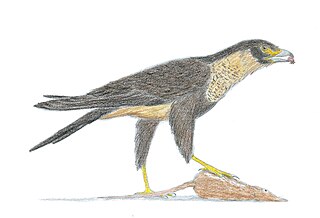 W
WMasillaraptor is an extinct genus of basal falconiform from the Middle Eocene, a long-legged relative of the living falcons.
 W
WMasillatrogon is an extinct genus of trogon. Its remains were found in the Messel Pit of Germany.
 W
WMesselastur is a genus of Messelasturidae bird. It is known from the Messel pit of Germany, which dates to the Eocene.
 W
WMesselasturidae is an extinct family of birds known from the Eocene of North America and Europe. Their morphology is a mosiac that in some aspects are strongly convergent with modern hawks and falcons, but in others are more similar to parrots. Initially interpreted as stem-owls, more recent studies have suggested a closer relationship to parrots and passerines. Their ecology is enigmatic.
 W
WThe extinct Messelirrisor is a genus of Bucerotiformes, the sole representative of the family Messelirisoridae. They were tiny hoopoe-like birds that were the earliest representatives of the hoopoe/wood-hoopoe lineage, and they were among the predominant small forest birds of Central Europe during the Middle Eocene. Fossilized remains of Messelirrisor have been found in the Messel Pit of Hesse, Germany.
 W
WNahmavis is genus of prehistoric birds related to Gruiformes and Charadriiformes. It is known from the Green River Formation of Colorado, Wyoming, and Utah.
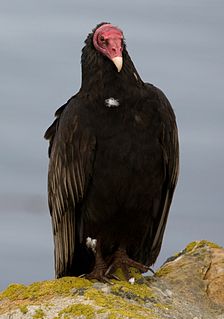 W
WThe New World vulture or condor family, Cathartidae, contains seven extant species in five genera. It includes five extant vultures and two extant condors found in warm and temperate areas of the Americas. The "New World" vultures were widespread in both the Old World and North America during the Neogene.
 W
WPachydyptes is an extinct genus of penguin. It contains the single species Pachydyptes ponderosus, the New Zealand giant penguin. This taxon is known from a few bones from Late Eocene rocks in the area of Otago, which were found in two clades near a base of a tree.
 W
WPalaeeudyptes is an extinct genus of large penguins, currently containing four accepted species. They were probably larger than almost all living penguins, with the smaller species being about the size of an emperor penguin and the largest ones having stood about 2 metres (6.6 ft) tall.
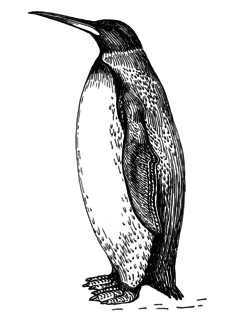 W
WPalaeeudyptes klekowskii, also known as the colossus penguin, was a species of the extinct penguin genus Palaeeudyptes. It was until recently thought to have been approximately the size of its congener Palaeeudyptes antarcticus, which would mean it was somewhat larger than the modern emperor penguin, but a new study shows it was in fact almost twice as tall. Knowledge of it comes from an extensive collection of fossil bones from the Late Eocene of the La Meseta Formation on Seymour Island, Antarctica. P. klekowskii was at first not recognized as a distinct species, and despite the coexistence of two so closely related species of similar size as Palaeeudyptes gunnari and P. klekowskii seeming somewhat improbable, the amount of fossil material suggests that the two species are indeed diagnosably different.
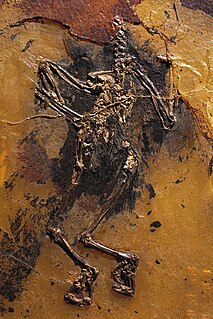 W
WPalaeoglaux is a genus of fossil owls from the Eocene epoch. The two known species are P. perrierensis from the Upper Eocene of Quercy, France, and P. artophoron from the Middle Eocene Messel shales, Germany. The holotype of P. perrierensis is a partial left coracoid in the Collection Université Montpellier, accession number PRR 2585. The four paratypes are the distal part of a left humerus (PRR2591), the proximal part of a left ulna, the distal part of a left ulna, and the distal part of a right tarsometatarsus. The type specimen of P. artophoron is a fossil slab and counterslab containing most of the postcranial skeleton and some feather impressions. This specimen is in the collection of the Forschunginstitut Senckenberg, accession number SMF-ME 1144 A and B.
 W
WPresbyornis is an extinct genus of anseriform bird. It contains two unequivocally accepted species; the well-known P. pervetus and the much lesser-known P. isoni. P. pervetus was approximately the size and shape of a goose, but with longer legs; P. isoni, known from a few bones, was much larger, more than swan-sized. Other fossils, more doubtfully assigned to this genus, are also known.
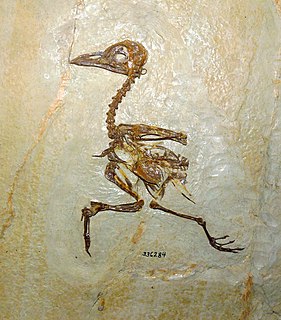 W
WPrimobucco is an extinct genus of bird placed in its own family, Primobucconidae. The type species, Primobucco mcgrewi, lived during the Lower Eocene of North America. It was initially described by American paleo-ornithologist Pierce Brodkorb in 1970, from a fossil right wing, and thought to be an early puffbird. However, the discovery of a further 12 fossils in 2010 indicate that it is instead an early type of roller.
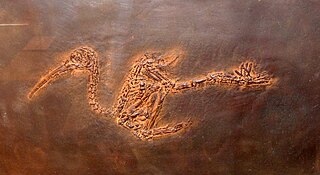 W
WRhynchaeites is an extinct genus of Threskiornithidae related to modern ibises and has a single named species Rhynchaeites meselensis. It lived in today's Germany during the mid-Eocene and its remains were found in the famous Messel pit.
 W
WSanshuiornis is an extinct genus of bird from Middle Eocene deposits of Guangdong Province, south China. It is known from the holotype IVPP V18116 an articulated complete right leg and foot. It was found from the black oil shales of the Huayong Formation of the Sanshui Basin, near Foshan. It was first named by Min Wang, Gerald Mayr, Jiangyong Zhang and Zhonghe Zhou in 2011 and the type species is Sanshuiornis zhangi. Sanshuiornis shows resemblances to some Ciconiiformes birds.
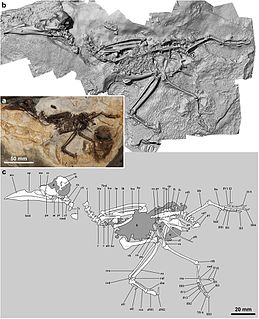 W
WSeptencoracias is an extinct genus of bird related to modern rollers and other Coraciiformes such as kingfishers, bee-eaters, motmots, and todies. It contains one species, Septencoracias morsensis. It was found in the Fur Formation of Denmark, dating back to the Ypresian of the Lower Eocene Epoch, about 54 million years ago. Septencoracias is one of the earliest known members of Coraciiformes, lending insight into the earliest radiation of this group.
 W
WStrigogyps is an extinct genus of prehistoric bird from the Middle Eocene to Early Oligocene of France and Germany. It was probably around the size of a large chicken or a guan, weighing not quite 1 kilogram (2.2 lb). Apparently, as indicated by the ratio of lengths of wing to leg bones, S. sapea was flightless. Its legs were not adapted to running, so it seems to have had a walking lifestyle similar to trumpeters. Unlike other Cariamiformes, which appear to have been mostly carnivorous, Strigogyps specimens suggest a herbivorous diet.
 W
WTynskya is a genus of Messelasturid bird. It is known from a fossil of the North American Green River Formation and the London Clay Formation of England, both from the early Eocene.